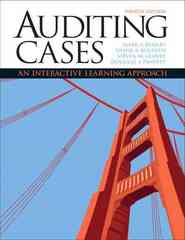Question
Imagine that a parent, Katherine, is developing rules governing the social activities of her teenage daughter, Lina, who is a senior in high school. Katherine
Imagine that a parent, Katherine, is developing rules governing the social activities of her teenage daughter, Lina, who is a senior in high school. Katherine has not articulated a comprehensive set of rules in the style of a statute or set of administrative regulations. Instead, Katherine provides guidance by admonishing Lina when she disapproves of Lina's actions and by expressing satisfaction when she approves, just as a court might develop the law incrementally by deciding disputes one case at a time.
In each of the following four "cases," put yourself in Lina's place by examining the facts, Katherine's statements, and Katherine's apparent or stated concerns. Then identify one or more reasonable interpretations of the "holding" of each case and translate it into a rule or set of rules that will govern Lina's future behavior.
Specifically, first determine the "ruling" in each case by determining whether Lina has apparently met or disappointed Katherine's expectations. Then, try to determine the "holding" of each case by identifying the facts that seem to be important to Katherine's ruling. Finally, engage in an ongoing process of "synthesis," by comparing each new holding to previous ones. Through this comparison, and by using inductive reasoning to generalize from specific cases, try to infer a rule or set of rules that will apply to Lina's future actions. This rule should evolve as more cases are added to your ongoing synthesis.
Is the first case ambiguous, inviting several reasonable arguments about the factual basis for Katherine's disapproval? If so, does its holding become clearer as you synthesize it with the second case? How does the third case add a second rule, or a second branch to the rule? How do you reconcile the fourth case with the previous ones?
Is the first case ambiguous, inviting several reasonable arguments about the factual basis for Katherine's disapproval? If so, does its holding become clearer as you synthesize it with the second case? How does the third case add a second rule, or a second branch to the rule? How do you reconcile the fourth case with the previous ones?
1.Case #1: The Pizza Hideout
On the first Friday night of the school year, Lina and Lynn, two seniors in high school, went to JJ's Pizza after their school's first football game of the season. They ate and talked until 11 p.m.; indeed, Lina was so engaged in conversation that she didn't answer a call to her cell phone from her mother, Katherine. When Lina walked into her house shortly after 11 p.m., she and Katherine had the following exchange:
Katherine:
"Lina, where have you been? The game ended at 9:30, and you're coming home after 11."
Lina:
"Well, some of us went to JJ's afterwards for pizza."
Katherine:
"So you were at JJ's! And you didn't answer your cell phone!"
Lina:
"Sorry."
Katherine:
"Well, being sorry is not good enough. You're not going out for the rest of the weekend."
2.Case #2: Pizza Reprise
On the second Friday night of the school year, Lina attended the second football game and again went to JJ's afterwards for pizza. Before entering JJ's, Lina called her mother, Katherine, from the parking lot and informed Katherine of her plans. In response, Katherine wished Lina a good time and reminded her to drive carefully. When Lina entered her home shortly after 11 p.m., she had the following exchange with Katherine:
Katherine:
"Did you have a good time?"
Lina:
"We lost the football game, but the pizza was good."
Katherine:
{hugging Lina} "Good. Well, goodnight."
3.Case #3: Closing Out JJ's
On the third Friday night of the school year, Lina attended the football game with Lynn and watched her school's team win for the first time this season. After Lina notified Katherine by cell phone that she planned to go to JJ's for pizza, Lina and Lynn celebrated by eating and talking at JJ's until JJ's closed at midnight. When Lina entered her home shortly after midnight, she and Katherine had the following exchange:
Katherine:
{angrily} "Lina, it's after midnight!"
Lina:
"I told you we were going to JJ's afterward."
Katherine:
{firmly} "It's good that you called me, but it's after midnight now. I need to draw the line somewhere."
Lina:
"So you mean I can't stay out past midnight? Why? Why do you care? Why do we have to set rules and limits like this? I always complete homework, and I get straight As."
Katherine:
"Yes, I'm really proud of you. But I care what you do during nightime. I worry about your safety, and I want you to get enough sleep and stay healthy. That's why I have rules. Now goodnight."
4.Case #4: The Obligatory Wedding Reception
On the Saturday night of the fourth week of the school year, Lina accompanied her mother to a relative's wedding and reception. When they entered the house after midnight, they had the following exchange:
Lina: {wearily} "I can't believe you made me stay at your nephew's wedding all night; I was so bored."
Katherine: "Hey, John is your cousin, too. And we had a blast on the dance floor, dancing to those old tunes."
Lina: {complaining} "Yeah, I know. You even talked to everybody after the band stopped playing. And it's after midnight! We have to go to church tomorrow morning."
Katherine: "Yes, I know, but this was an important family event. Thank you for staying up late with me."
Step by Step Solution
There are 3 Steps involved in it
Step: 1

Get Instant Access with AI-Powered Solutions
See step-by-step solutions with expert insights and AI powered tools for academic success
Step: 2

Step: 3

Ace Your Homework with AI
Get the answers you need in no time with our AI-driven, step-by-step assistance
Get Started


